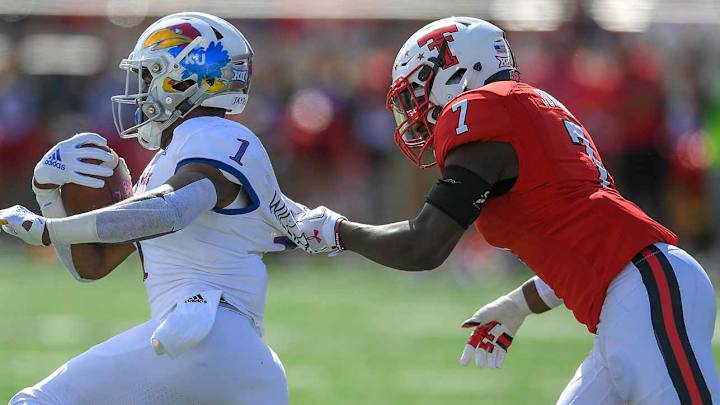How Texas Tech's Defense Has Worked to Reshape Its Reputation

Two years after one of the worst nights of their lives, Texas Tech defenders still don’t like to talk about it. “We had a couple of freshman guys playing,” Red Raiders safety Jah’Shawn Johnson says of a 66–59 loss to Oklahoma that set multiple FBS offensive records that still stand. “We just had to throw a couple of guys in the fire and try to survive.”
They lived, but they were scarred. “A huge part of this job is being a psychologist,” Texas Tech coach Kliff Kingsbury says with a laugh. But he’s not completely kidding. The 2016 Red Raiders had quarterback Pat Mahomes at the height of his collegiate powers, but they went 5–7 largely because of a defense that couldn’t do the two things defenses must do to cope in the pass-happy Big 12: create turnovers and get off the field on third down.
That defense had the misfortune of being terrible at both of those things. In 2016, Texas Tech ranked No. 112 in the nation in takeaways with 13 and No. 100 in opponent third down conversions, allowing 43.3% of third downs to turn into first downs.
As the Red Raiders prepare for Oklahoma’s first visit to Lubbock since that fateful night, they still have the reputation of a team that must score every time it has the ball to win. But the numbers tell another story. This defense now contributes to Texas Tech wins, and it will need to play its best game to give the Red Raiders a chance against an Oklahoma offense that—crazy as it may sound—might be better than the one that went wild in Lubbock two years ago and the one that averaged 7.6 yards a play in a 49–27 win in Norman last year.
How has Texas Tech’s defense changed? The turnovers came first. The Red Raiders’ third-down numbers barely improved last year (92nd in the nation, 42.1%), but their takeaways skyrocketed to sixth in the nation (29). The Red Raiders intercepted Texas quarterback Sam Ehlinger twice and recovered two fumbles in the 27–23 regular-season finale win in Austin that made Texas Tech bowl eligible. “In the Big 12, there are just a lot of high-powered offenses,” linebacker Dakota Allen says. “In the Big 12, offenses are going to score. That’s just the nature of it. Our job is to slow the offense down or take it away. Takeaways are big, because those are possessions they don’t get back.”
The Red Raiders aren’t pilfering the ball so frequently this season, but they are getting off the field on third down—which is just as important when you’re a team with an offense that can light up an opposing defense. Entering Saturday, Texas Tech ranks 21st in the nation in that category, allowing opponents to convert only 32.5% of their third downs. Coordinator David Gibbs spent much of spring practice and preseason camp stressing situational awareness. Offenses go so fast in the Big 12 that it’s sometimes difficult to keep track of down and distance. Gibbs made sure players keep talking so everyone on the field knows when the Red Raiders have a chance to get off the field.
Allen hates watching an offense get a fresh set of downs. “That’s just the worst feeling,” he says. “We’re right there.” Now, he loves handing the ball back to an offense—whether it’s being piloted by freshman slinger Alan Bowman or dual-threat sophomore Jett Duffey—that can score at any moment.
That will be especially important Saturday, because Oklahoma converts 48.7% of its first downs and leads the nation with an obscene 8.9 yards a play. That fresh set of downs probably will lead to a touchdown thanks to quarterback Kyler Murray, who is somehow posting better numbers than former Sooners quarterback Baker Mayfield did during his Heisman Trophy season last year.
In Oklahoma’s only loss (48–45 to Texas on Oct. 6), the Sooners converted only three of eight first downs. They also played so poorly on defense that coordinator Mike Stoops got fired the next day. It remains to be seen whether new coordinator—and former Texas Tech coordinator—Ruffin McNeill has truly made an improvement on that side of the ball because the offenses at TCU and Kansas State don’t offer nearly the challenge Texas Tech’s will. (Case in point: Texas Tech’s defense essentially shut down TCU’s offense in a 17–14 win on Oct. 11. Oklahoma beat the Horned Frogs 52–27 on Oct. 20 in McNeill’s first game as defensive coordinator.)
One former Red Raiders player and coach has noticed how different the Red Raiders’ defense has looked compared to past seasons. “It’s a lot of the same guys and the same names that we’ve been seeing for two or three years,” Sooners coach Lincoln Riley said. “And those guys have gotten better.”
They’ll have a chance to prove exactly how much better on Saturday against the nation’s most explosive offense. “We don’t want to just be known as an offensive school,” Allen says. “We want to be known for playing some defense as well.”
